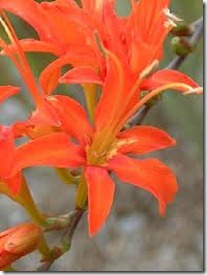Crocosmia, also known as montbretia, is a sturdy summer bloomer that produces masses of funnel-shaped flowers in bright shades of orange, yellow or red that rise above thick, strappy foliage. At maturity, crocosmia grows to heights of 2 to 3 feet. Native to South Africa, crocosmia is appropriate for U.S. Department of Agriculture hardiness zones 6 to 9. In cooler climates, the corms must be removed from the ground in autumn, then stored for the winter.
- Difficulty:
- Moderate
Instructions
things you’ll need:
- Spade
- Balanced garden fertilizer
- Mulch
- Shovel
- Paper bag or cardboard box
- Sawdust or peat moss
- Garden shears
- Plant crocosmia after the ground can be worked in springtime. Select a spot with well-drained soil, then spade a balanced fertilizer into the soil before planting. Apply the fertilizer according to the directions on the container. Crocosmia likes full sunlight but can also be planted in light shade. In warmer climates, crocosmia can be planted in either fall or spring.
- Water the crocosmia deeply so that the soil is saturated. After that time, crocosmia requires no supplemental irrigation until growth has emerged. After growth appears, saturate the soil every week to 10 days. Growth will appear in a few weeks.
- Spread 2 to 3 inches of mulch over the planting area after planting the crocosmia. Mulch will keep the soil moist and to deter growth of weeds.
- Fertilize crocosmia, using a general-purpose garden fertilizer, when the shoots are 6 to 8 inches tall. Fertilize the plants again when the blooms appear.
- Clip crocosmia blooms as often as desired for cut flower bouquets. Deadhead, or removed expired blooms regularly, but don’t remove the foliage until it dies down naturally.
- Divide crocosmia every three to four years to keep the plant from becoming overcrowded. Don’t divide the plant more often, as crocosmia blooms most profusely when the plant is slightly crowded. Dig the entire clump of crocosmia in autumn, then divide the plant into smaller sections. Plant the smaller sections in a prepared spot. Throw away any sections that look unhealthy or unproductive.
- Dig crocosmia corms after the foliage dies down in autumn if you live in a climate cooler than U.S. Department of Agriculture zone 6. Place the corms in a sheltered spot to dry for one or two days, then place the corms in a paper bag or cardboard box filled with sawdust or peat moss. Store the bulbs in a cool, dry room where temperatures will be between 35 and 45 degrees Fahrenheit. Replant the crocosmia corms in spring.


Deprecated: strpos(): Passing null to parameter #1 ($haystack) of type string is deprecated in /home/agriviek8Qv/agriviet.net/public_html/wp-includes/comment-template.php on line 2522